Hey travelers! Whether you're tagging along on one of our unforgettable tours or just happen to be an insatiable history buff, you're in for a treat. We're diving deep into Delphi, one of Greece's most jaw-dropping destinations! A place so mystical, even the ancient gods couldn't stay away. Use this guide as your go-to resource to unlock the secrets of Delphi and its captivating outskirts. Trust me, you don't want to miss out on this epic journey through time! So grab your sandals and let's hit the ancient trail, shall we?
Delphi

Situated 2.5 km southeast of the town of Amfissa, the village of Delphi serves as a gateway to its proximate, historically significant archaeological site. With a population of 1,499, the village offers travelers a starting point from which to embark on a comprehensive exploration of the ancient ruins, a venture that necessitates at least a full day.
The Delphi archaeological site is uniquely situated in an amphitheater-like setting, punctuated by a hypsometric difference of 200 meters (656 feet). The site is framed by towering vertical rock formations known as the 'Fedriades Stones'. Among its array of ruins, one will encounter remnants of the Temple of Apollo, the vestiges of the 'Sacred Way,' and the remains of treasuries that once belonged to various city-states. Notably well-preserved is the Athenian Treasury. The site also encompasses the Castalian Spring, the crumbling edifice of a Gymnasium, and ruins of the Temple of Athena Pronaia, a sanctuary of paramount significance to Delphi.
Housed within its vicinity is the Museum of Delphi, featuring 13 rooms replete with an assortment of artistic contributions ranging from ceramics and figurines to sculptures, bronze weapons, tools, and inscriptions, covering a chronological span from the Prehistoric era to Roman times.
The site was held in the highest esteem by ancient civilizations, considered the "navel of the world" and the most sacred of places. The importance of Delphi was first recognized through excavations initiated by the French Archaeological Faculty in 1860. These digs revealed that the area had been inhabited since as early as 1400 B.C., linking the site's history inextricably with that of Apollo's sanctuary and oracle.
Initially, Delphi was governed by the Phocians of Crissa. In a pivotal moment in 590 B.C., with the collaboration of multiple Greek city-states, Delphi waged what became known as the First Sacred War against Crissa, culminating in the latter's destruction. From that point onward, Delphi emerged as a central locus for the Amphictyonic League and the broader Greek city-states. It became host to the Pythian Games, initiated in 582 B.C. and held quadrennially. Throughout its long history, Delphi faced multiple instances of devastation—at the hands of the Persians in 480 B.C., the Phocians in 355 B.C., and the Gauls in 279 B.C. Subsequent Roman intrusions led to plundering, most notably by General Sulla in 86 B.C., followed by a succession of Roman emperors, including Nero, who expropriated 500 ornately sculpted statues for Rome.
During the early 2nd century AD, a resurgence of interest in the sanctuary occurred under the reign of the philhellenic Emperor Hadrian, who engaged in various building projects. Yet, the closure of the Oracle of Delphi was precipitated by the decree of Byzantine Emperor Theodosius in AD 392, effectively outlawing the ancient religion and forbidding the adoration of statues, along with the celebration of the Pythian Games.
Museum of Delphi
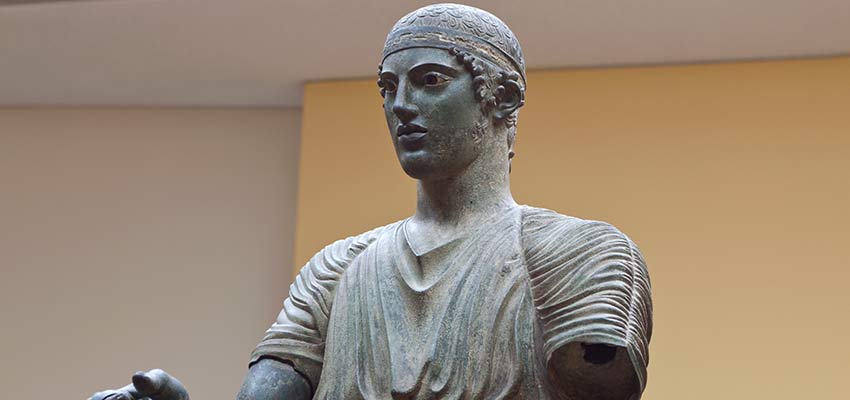
The Delphi Archaeological Museum holds a collection whose significance is rivaled only by that of the Acropolis Museum in Athens. Upon entering the facility, visitors are immediately greeted by the Omphalos or 'navel' stone, a Hellenistic or Roman replica of the legendary stone that, according to myth, was situated at the point where the eagles dispatched by Zeus converged. This celestial alignment ostensibly identified Delphi as the earth's center.
The museum's layout consists of 13 rooms, all located on the ground level, each featuring a variety of exhibits. One room houses a meticulously crafted scale model that brings to life the Sanctuary of Apollo, replete with details in limestone whites, blue marble, gold, and terracotta. Among the collection's highlights is the Sphinx of Naxos, a towering artifact that measures 7.5 feet in height. Donated by the affluent citizens of Naxos in 560 BC, this colossal sphinx once surmounted a column that extended more than 33 feet in height.
However, the museum's pièce de résistance is a life-size bronze statue known as the Charioteer of Delphi. Commissioned by Polyzalos, a Sicilian "tyrant", this statue was erected to celebrate a chariot-racing victory at the Pythian Games in 478 BC.
Oracle of Delphi

The Oracle of Delphi, situated in Phocis, was the preeminent oracular institution in ancient Greece. Established in the 8th century B.C. in proximity to the Castalian Spring, the oracle was historically shrouded in myth. According to legend, the site was originally guarded by a dragon named Python, who was subsequently vanquished by Apollo. In recognition of this event, Apollo, also known as Apollo the Pythian, became the chief deity worshiped at Delphi. A temple dedicated to Apollo was constructed, and the inaugural priests were said to have traveled from the island of Crete to officiate religious rites.
Initially, the act of divination at Delphi was performed using a drawing method, where prophetic messages were gleaned based on the shape and color of objects pulled from a container. Additional methods of prophecy evolved over time. One such method, known as 'eghimiseos,' involved a petitioner sleeping near the sanctuary, where it was believed that the deity would convey messages through dreams.
In due course, the role of Pythia emerged as the high priestess of the Delphic Oracle, a title said to derive from Python, the slain dragon. Contrary to the assertion that each Pythia was over 50 years old, historical records suggest a range of ages for women who served in this role. Traditionally, the Pythia was seated on a tripod above a chasm, from which fumes emanated. While chewing bay leaves, she would inhale these fumes, entering a trance-like state. Due to the esoteric language or form of utterance used by the Pythia during these trances, the priests often faced challenges in interpreting her prophetic utterances, which resulted in cryptic and sometimes ambiguous answers.
Despite the opacity of the Pythian responses, the Oracle of Delphi gained an enduring reputation for accurate prognostications. Over centuries, individuals not only from various Greek city-states but also from broader Mediterranean cultures—including Romans and Egyptians—sought guidance from the oracle, attesting to its far-reaching influence and authority.
Castalian Spring
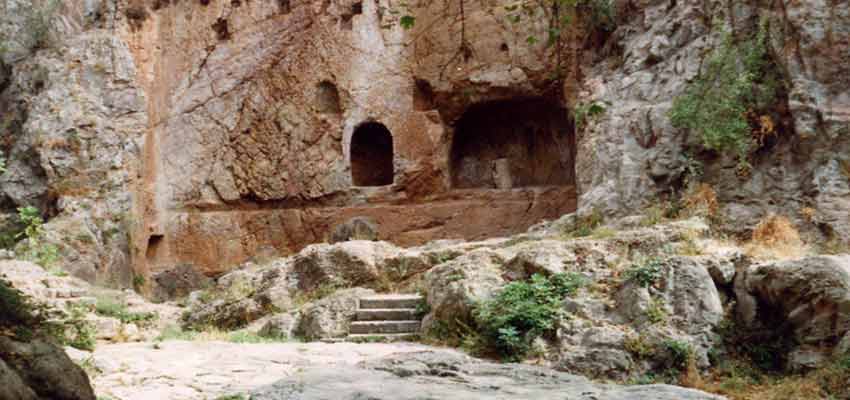
Before accessing the Sacred Precinct of Delphi, it is traditionally believed that visitors—including athletes participating in religious ceremonies or competitions—were obliged to undergo a purification ritual using the waters of the Castalian Spring. This practice primarily entailed the washing of one's hair. The Pythia, or the Oracle of Delphi, would also perform ablutions in these waters prior to issuing her divinations. The extant remains of the fountain can be dated to either the late Hellenistic period or the early Roman era, providing a chronological framework for the infrastructure surrounding the spring.
Adjacent to the fountain, a series of niches carved into the rock once held votive offerings. These were dedicated to the nymph Castalia, the mythological guardian of the spring. An anecdotal layer to the spring's history suggests that the British romantic poet Lord Byron once immersed himself in the waters, motivated by the notion that they might imbue him with poetic inspiration.
Marmaria Precinct
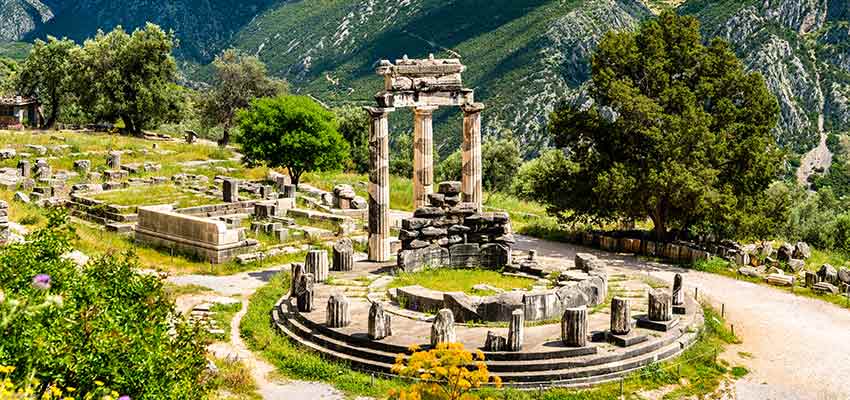
Southeast of the Temple of Apollo in Delphi, a pathway directs visitors to a zone known as the Marmaria Precinct, colloquially referred to as the "marble quarry." Within this precinct lies the Sanctuary of Athena Pronaia. As one enters the sanctuary, the remnants of a 4th-century BCE temple dedicated to Athena are immediately apparent. Farther within the confines of the sanctuary are the vestiges of a more archaic temple, constructed around 510 BCE, also consecrated to Athena.
The architectural highlight of the Marmaria Precinct is undoubtedly the Tholos, a circular structure of enigmatic purpose. Situated equidistant between the two temples of Athena, the Tholos is often the focal point of photographs and scholarly speculation alike. Dating to the early 4th century BCE, the rotunda was originally encircled by a peristyle of 20 columns. In an effort to provide a semblance of the structure's former grandeur, three of these columns were re-erected in 1938.
While the Tholos captivates attention, its original function remains elusive, and its purpose has yet to be definitively established through scholarly inquiry or archaeological evidence. Thus, the Tholos continues to be an object of fascination and speculation in the studies of ancient Greek architecture and religious practices.
The Ancient Stadium
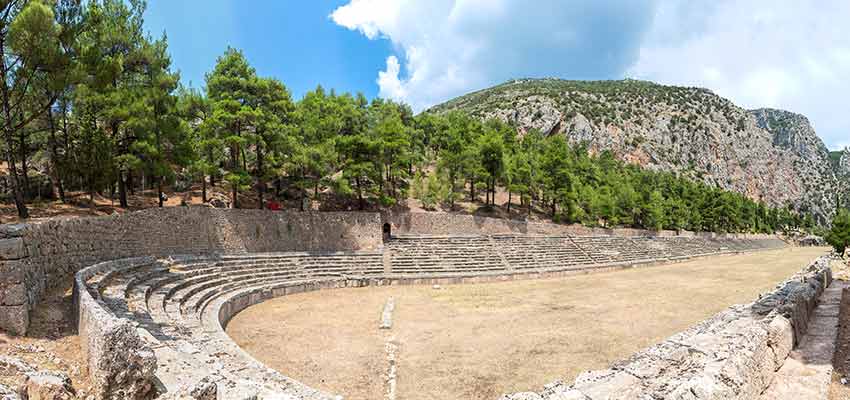
Situated above the main sanctuary in Delphi, the stadium is an exemplar of well-preserved ancient Greek athletic architecture. Measuring approximately 200 meters (656 feet) in length, the stadium is partially carved into the natural rock formations of the locale. Originally conceived as the focal point for track and field competitions, it was an integral component of the quadrennial Pythian Games, accommodating an audience of up to 7,000 spectators.
The existing edifice, constructed entirely of limestone, can be attributed to the Roman period, rather than the original Greek construction. The seating arrangements reveal a hierarchy of social status and function: The best-preserved seating, featuring backrests, is located on the northern side of the stadium. These seats were reserved for the presidents of the games and other esteemed guests.
The Monastery of Hosios Loukas
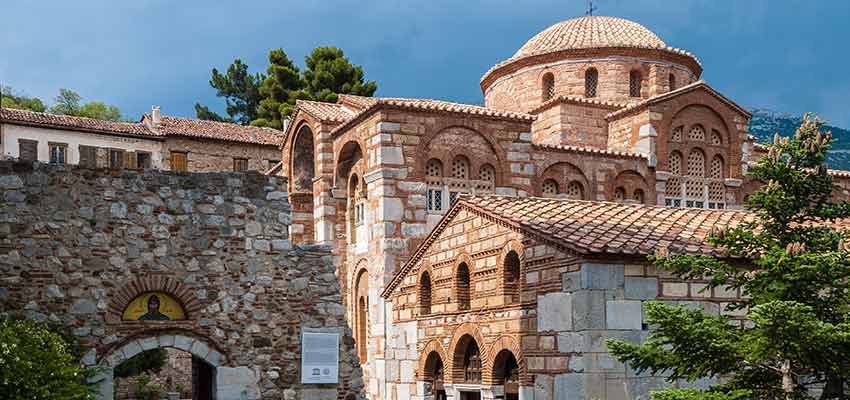
Constructed in the first half of the 11th century on the western slope of Mt. Helikon, beneath the acropolis of ancient Stirion, the Monastery of Hosios Loukas stands as a monument of considerable significance during the mid-Byzantine period in Hellenic history. Over the span of ten centuries since its inception, the monastery has been a focal point in the historical developments of the region, enjoying the patronage of Byzantine emperors and other dignitaries.
Hosios Loukas, the monastery's namesake (where "Hosios" translates to "saint" in Greek), established himself at this verdant, atmospheric location in 946, at approximately 49 years of age. Here he constructed a cell, a small chapel for prayer, and a garden where he cultivated vegetables. Assisted by an influx of followers and the financial support of admirers, including state dignitaries and military generals, he initiated the building of the Church of Saint Barbara, a project he did not live to see completed. Predicting his own death in November 952, Loukas passed away on February 7, 953, at the age of 56 years, seven months, and eight days. He was interred in his cell by his disciple Grigorios.
Following his death, rumors of the miraculous nature of his relics attracted a large number of believers seeking cures for various ailments. The monastery became a sanctuary where not only were physical healings reported, but where Hosios Loukas was also credited with prophetic visions. Among these were the raid of the Bulgarians and the liberation of Crete from Arab control, the latter occurring in 961, validating a prophecy he had made in 942. This prescient ability, coupled with his perceived healing powers, contributed to the profound veneration he received, particularly from the Byzantine capital of Constantinople.
Mountain Town of Arachova
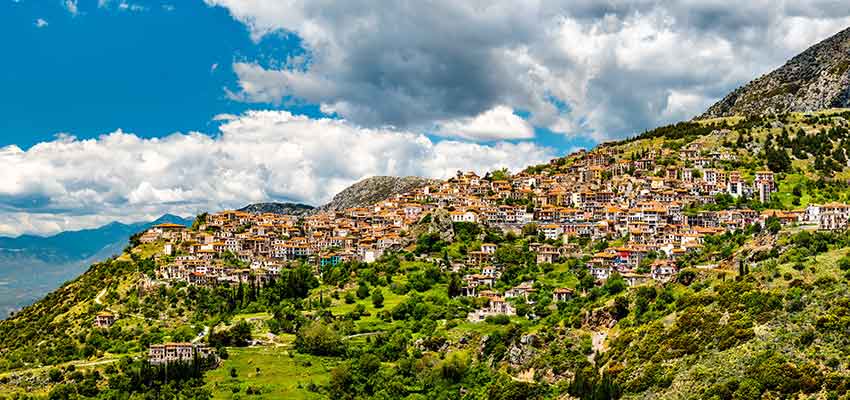
Situated at the foothills of Mount Parnassus, which towers at an elevation of 2,457 meters (8,061 feet), Arachova is a picturesque town renowned for its diverse climatic conditions and natural splendor. The town experiences a relatively cool but generally dry summer, followed by a rainy autumn and an extended winter season. The surrounding landscape is characterized by alpine meadows at elevated altitudes, barren rock formations, and a remarkable forest replete with endemic firs.
The Corycian Cave, a noteworthy site proximate to Arachova, has not only been the subject of fables but was also well-known to ancient chroniclers. Pausanias, the ancient Greek historian who visited the cave in the 1st century CE, described it as one of the most impressive caverns he had encountered. The cave's interior is adorned with abundant stalactites that create an ensemble akin to "abstract art." It is surmised that the Corycian Cave has existed since prehistoric times and is located approximately 10 kilometers from Arachova en route to Mount Parnassus.
Arachova has garnered fame for its agricultural and veterinary activities, as well as for the high-quality products it yields. The concept of producing biologically and ecologically sound goods—those fashioned naturally or from unadulterated materials—is not novel to the inhabitants of Arachova. This practice, demonstrated by the town's general longevity, has been a cornerstone of their way of life for centuries.
Among the renowned products originating from Arachova are:
- Honey – Derived from the wildflowers indigenous to Mount Parnassus.
- Formaela Cheese – A gastronomic delicacy unique to Arachova, this cheese enjoys a protected designation of origin within the European Union. It is crafted through a specialized method.
- Olive Oil
- Marmalade